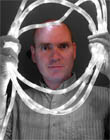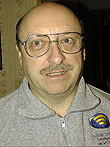|
|
This topic comprises 2 pages: 1 2
|
|
Author
|
Topic: Patriot looks grainy
|
|
|
|
|
Dave Cutler
Master Film Handler
Posts: 277
From: Centennial, CO
Registered: Jun 2000
|
 posted 06-29-2000 10:02 AM
posted 06-29-2000 10:02 AM




Actually "Patriot" is scope, and I think "The Green Mile" was too, hard to remember them all. Anyway, I know what you are talk about, it has something to do with how the movie was filmed. There most likely isn't anything wrong with what the theatre is doing. Especially if it's only part of the movie, if it was the entire movie well then it could be a light problem.
------------------
Dave Cutler
"Do or do not, there is no try."
| IP: Logged
|
|
|
|
|
|
|
|
|
|
|
|
|
|
John Pytlak
Film God

Posts: 9987
From: Rochester, NY 14650-1922
Registered: Jan 2000
|
 posted 06-30-2000 07:34 AM
posted 06-30-2000 07:34 AM





Brett:
The "dark purple" areas near the lab splices were probably from excessive exposure of the undeveloped film to the "safelight" used to illuminate the splicing area at the lab. There may have been a problem that caused the lab technician to take longer than normal to make the ultrasonic splice. The horizontal white bands may be due to some flicker in the printer light output --- contact printers move the printing negative and raw stock print film past a narrow aperture, and a flicker in the light output would cause a horizontal light band. Excessive safelight fogging and obvious printer problems are valid reasons to request a replacement reel.Brad:
You are correct. Graininess is very dependent on the choice of camera format ("flat", Super-35, or anamorphic), film speed, and film exposure. In general, the larger the image area on the negative, the lower the graininess. A slower film like KODAK VISION 200T Color Negative Film (5274) is less grainy than a high speed film like KODAK VISION 800T Color Negative Film (5289). Underexposure tends to produce more graininess and more "smoky" shadows. Film type, exposure and even camera negative format can vary scene-to-scene in a feature, often depending upon the "look" desired for a particular scene. (Recall that for "Little Buddha", Storaro actually intercut scenes shot in 65 mm with scenes shot in 35 mm to achieve a sharper, grain-free look for the Buddha scenes). ------------------
John P. Pytlak, Senior Technical Specialist
Worldwide Technical Services, Entertainment Imaging
Eastman Kodak Company
Research Labs, Building 69, Room 7419
Rochester, New York, 14650-1922 USA
Tel: 716-477-5325 Fax: 716-722-7243
E-Mail: john.pytlak@kodak.com
| IP: Logged
|
|
|
|
|
|
Greg Anderson
Jedi Master Film Handler

Posts: 766
From: Ogden Valley, Utah
Registered: Nov 1999
|
 posted 06-30-2000 04:17 PM
posted 06-30-2000 04:17 PM





Perhaps I've misunderstood how cinematographers work in general, but in publications like American Cinematographer I keep reading things like..."The large softbox was used to get an ambient source that would produce enough light for Kimball to work at his preferred stop of T8/5.6." (From the article about Mission: Impossible 2.) or "I was shooting the night exteriors at about a T-2.8/3.2 on the C-series and at more of a T-5.6/8 for day exteriors." (From the article about Gone in 60 Seconds.) or "Thorin used Kodak's 500T Vision 5279 stock for night exteriors and most interiors, and Kodak's 250D Vision 5246 for daylight exteriors?" (From the article about Shaft.) And that's all from just one issue! But now you guys have me extremely curious to read what they'll print about The Patriot. Oh, wait! Here's an even better quote from the article about The Perfect Storm... "Seale and Peterson also elected to shoot the film in the anamorphic format, which created its own set of considerations. The anamorphic zooms would be considerably slower than spherical zooms or primes, and there was also significant concern regarding focus because the entire film would be photographed primarily wide open at a T4.5. 'I opted to shoot anamorphic rather than Super 35 because I felt the quality improvement was a significant advantage for the film,' Seale asserts. 'It made things a bit more difficult, however, because I had to light everything up. I just said to the guys in preproduction, "Your stop is a T4.5. Lock it off!" The 8-perf VistaVision cameras from ILM were all T4.5 as well, so the whole film was planned for that stop.'"
| IP: Logged
|
|
|
|
|
|
|
|
All times are Central (GMT -6:00)
|
This topic comprises 2 pages: 1 2
|
Powered by Infopop Corporation
UBB.classicTM
6.3.1.2
The Film-Tech Forums are designed for various members related to the cinema industry to express their opinions, viewpoints and testimonials on various products, services and events based upon speculation, personal knowledge and factual information through use, therefore all views represented here allow no liability upon the publishers of this web site and the owners of said views assume no liability for any ill will resulting from these postings. The posts made here are for educational as well as entertainment purposes and as such anyone viewing this portion of the website must accept these views as statements of the author of that opinion
and agrees to release the authors from any and all liability.
|

 Home
Home
 Products
Products
 Store
Store
 Forum
Forum
 Warehouse
Warehouse
 Contact Us
Contact Us




 Printer-friendly view of this topic
Printer-friendly view of this topic


















